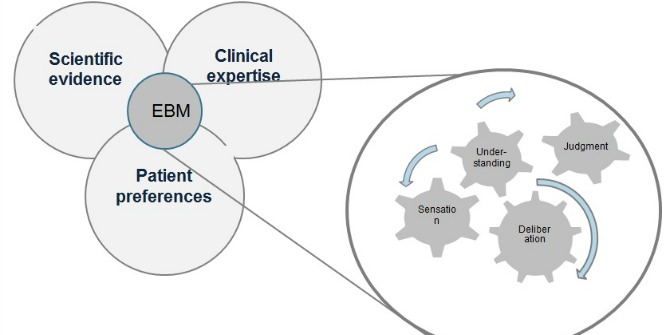| Section | Name | Description |
|---|---|---|
| 2. Critical Perspectives on EBM | Watch the video on BioMed Central and listen to two leading researchers talk about EBM and its strengths and weaknesses (you can activate subtitles in English!). Trish Greenhalgh is Professor of Primary Health Care and Dean for Research Impact at Bart's and the London School of Medicine and Dentistry, UK, while Neal Maskrey is Professor of Evidence-informed Decision Making at Keele University, UK. Both share a background in General Practice and are advocates of the campaign for real evidence-based medicine. Here Greenhalgh and Maskrey discuss the origins of evidence-based medicine, how it has gone astray, and what is needed to address some of the problems facing evidence-based practice today.
|
|
In the oral exam you will be asked general questions about Evidence-Based Medicine: For example: What is EBM? Can you give a definition? What are its strengthen and weaknesses? What types of study designs do you know? How are they different? What different clinical questions do they answer? The link to the paper Pros and Cons gives a detailed overview of the strengths and weakness to help you answer these questions. The resources links are also very recommended. |
||
This is a stimulating 14 minute talk on 'bad science 'by Ben Goldacre. It explains how important 'transparency' in clinical evidence is but also how easily evidence can be manipulated. You can listen to this talk with Italian subtitles. It provides a philosophical background to your EBM project and the idea of 'critical analysis'. |
||
These notes on EBM are by Theodore J Gaeta, DO, MPH, FACEP.
|
||
This is a short paper on types of bias in clinical research. Use it to help you analyse potential bias in your presentation |
||
| 3. EBM Exam Presentation Guide | This guide describes what information to include in your presentation, the titles you need to put on every slide, how many slides to use, and how to present the material. Your EBM presentation in the exam is worth 15/30. The table below has 15 sections. Each section explains criteria for 1 mark in the exam. Follow it carefully while you prepare your slides.
|
|
| 4. Clinical Study Designs | ||
These notes on EBM are by Theodore J Gaeta, DO, MPH, FACEP Assoc Prof Emergency Medicine. The link http://www.cebm.net/study-designs/ also provides a summary of pros and cons of different designs |
||
Here is a powerpoint presentation which explains different types of clinical studies (i.e. it describes different 'study designs) |
||
Here are some useful tools and checklists to help you evaluate different study designs for your EBM project |
||
| 5. ASKING CLINICAL QUESTIONS & PICO | Here is a short presentation describing PICOT (in case you have forgotten!) It explains the process of research preparation. This is a good guide for the exam! There are many other YouTube films and presentations on the internet you can consult for more help. |
|
This is a resource to help you refine your clinical questions. |
||
How do you write a focussed clinical question? This link will give you a head start using PICO to commence your EBM project. In the exam you must demonstrate you can do this (4/30) |
||
Ecco un'opportunità di approfindire le vostre conoscenze dell'Evidence based Medicine |
||
| 6. ONLINE STUDY RESOURCES | I recommend you explore the GIMBE web site. It is a pioneer site in Italian to spread knowledge about the basics of EBM. |
|
This University of Washington link offers many links to extend your knowledge of different aspects of EBM. It is designed for students and doctors. You will find useful links to find evidence and evaluate evidence. |
||
The TRIP Plus database is a meta-search engine that searches across multiple sites of high-quality medical information, including PubMed's Clinical Inquiries. TRIP Plus is an electronic resource. |
||
Listen to a short Podcast on RCTs and their strengths and weaknesses Randomized Trials Stopped Early for Benefit: Interview With Dr Victor MontoriReleased23 May 2011 Victor Montori, MD, discusses randomized trials that are stopped early for benefit. |
||
SUMSearch is a unique method of searching for medical evidence by using the Internet. SUMSearch combines meta-searching and contingency searching in order to automate searching for medical evidence. Meta-searching means simultaneously searching multiple Internet sites (including MEDLINE) and collating the results into one page.  |
||
| 7. Key Readings on EBM |
|
|
This third paper examines summaries of medical evidence and how to judge their quality. |
||
This is a second paper by Trisha Greenhalgh examining papers on drug trials. |
||
This papers gives a worked example of how to critically appraise a clinical study. It gives you a clear tool to analyses the papers in your own presentation. Spring07.pdf |
||
Here are some references. Make sure you consult at least one of these. |
||
| 8. BIbliographic Software |
All students need to choose one referencing software. This is a professional tool for all research, and is also essential for your thesis. The free software applications will make your bibliographies accurate and professional. Click on the link to download Mendele. http://www.mendeley.com |
|
Using Bibliographic Software
INSTRUCTIONS FOR INSERTING CITATIONS into your documents USING MENDELEY:
Some students have had problems inserting citations from their Mendeley library using Microsoft Word. You need to do this to complete the short summary exercises for each module online.So here is some help to solve the problem. After you download the free software 'Mendeley Desktop,' follow these instructions.
1. Download the Microsoft Word plug in for your browser from the link below 2. The plug-in gives you a link to Mendeley from your Microsoft Word toolbar. 3. From the menu choose the citation style (e.g. ‘Nature) for a Word document, or Harvard for a Power point presentation. 4. Put the cursor where you want to insert the references in your document 5. From the menu slect ‘Insert citation >Go to Mendeley and select the paper (or papers) you want to cite. Select the ‘Cite’ icon from the menu in your library. Mendeley will insert in-text numbers1 6. At the end of your work write the word ‘References,’ then select ‘Insert bibliography from the plug in menu in Word References (example using citation style ‘Nature’) 1. Alon, U. How to choose a good scientific problem. Mol. Cell 35, 726–728 (2009).
|
||
You must present a professional reference list, of publications, texts, images and web sites that you have used for your presentation. Refer to the link here from the US National library of Medicine for how to cite different kinds of texts. |
If you continue browsing this website, you agree to our policies:
x







